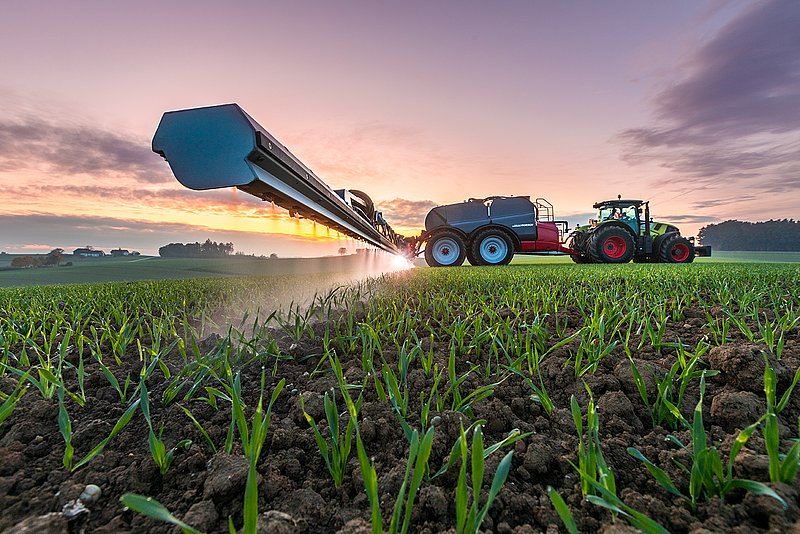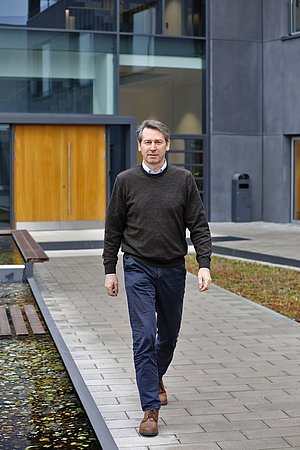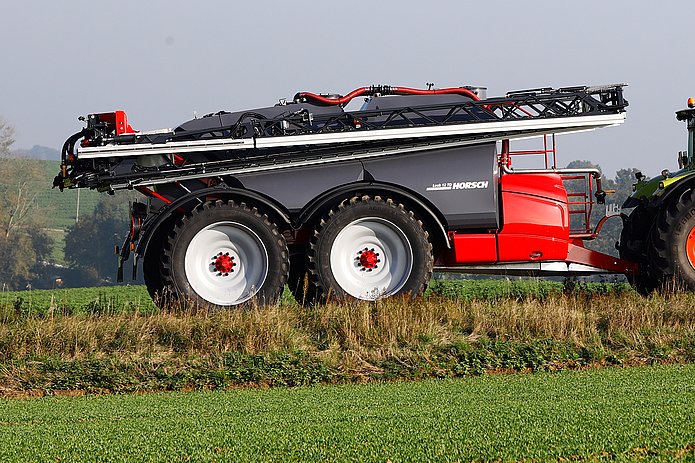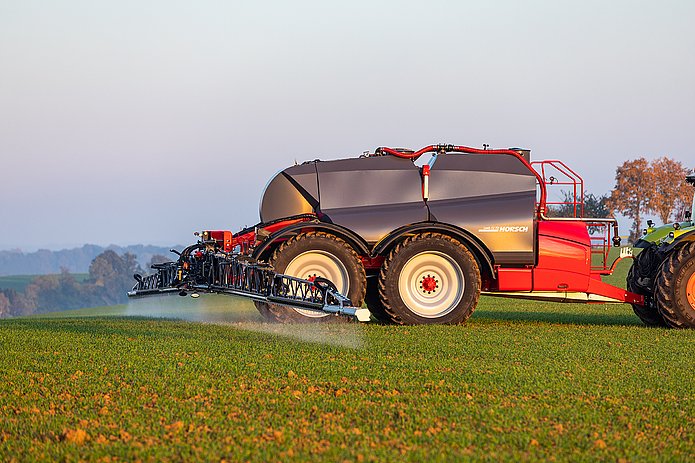
A double plus (Theodor Leeb)
This year, a trailed tandem sprayer with a capacity of 12,000 litre and a boom width of up to 45 metre was among the HORSCH innovations in the plant protection sector. Theo Leeb, managing director of the HORSCH LEEB Application Systems GmbH, explains the product in detail.
During the past years the number of machines as well as the market share of the HORSCH LEEB plant protection range increased significantly. Among the innovations of this year’s Agritechica was a new self-propelled sprayer generation and the HORSCH Leeb 12 TD. The latter is a trailed tandem sprayer.

terraHORSCH: Mr Leeb, why do you launch a tandem sprayer?
Theo Leeb: The principle of a trailed tandem sprayer, admittedly, is not completely new. There are competitors who have been offering such products for more than 20 years. We have been watching the sector for quite some time and we have been noticing that the topic is discussed time and again, but that the demand also decreases rather fast. The large tank capacity is to increase the acreage performance and to ease the logistic problem if large distances have to be covered between the farm and the fields. On even sites or light soils you can drive on even if it is wet the high weight of the machine usually does not cause any major problems. However, the system soon reaches its limits in hilly terrain. In this case, the tractive power of the tractor often is no longer sufficient. Track damages are the result. So far, this problem has been solved by means of for example retractable axles or a traction reinforcement.
terraHORSCH: And it works?
Theo Leeb: Only to a limited extent. The problem actually is quite an easy one: Because of its design the tank of the tandem sprayers is long and slim. If the tank is only partly filled or if you go up a hill the spraying mixture moves backwards. Thus, the centre of gravity changes and the load at the front of the sprayer is reduced. The result is a negative vertical load what in turn means less weight on the rear axle of the tractor. This causes traction problems. To solve this, some tractors are equipped with wheel weights. This, however, is rather counterproductive. For after all we do not want to enter the field with more weight than necessary. With a retractable axle the vertical load at the tractor is kept up, but there is even more load on the rear tandem axle – the consequence of this high axle load might again be unnecessary tracks. Therefore, tandem sprayers so far have rather been a product for a niche market.
terraHORSCH: A market that you are going to enter now…
Theo Leeb: We thought long and hard about it. So far, tandem sprayers have mainly been working on large farms in Eastern and Northern Germany. In Eastern Europe, the farmers either use smaller, trailed sprayers or self-propelled sprayers. In my opinion, the reason is the tractor park of the farms. Among the traditional Belarus tractor and the large articulated tractor or the tractor with power tracks there hardly ever is a large tractor with 250 and 300 hp. However, we notice that the staff topic becomes more and more important even on Eastern European farms. As a result, especially in the plant protection sector larger machines will get more important. The HORSCH Leeb 12 TD can be an excellent alternative to a self-propelled sprayer that can show its strength especially if a high clearance (up to 1.35 metre) is required, for example for a late maize or sunflower treatment. In many crops or vegetation periods, however, clearance only plays minor role. In our opinion, a rig that consists of a modern tractor and a large, trailed sprayer is an interesting possibility to carry out efficient plant protection treatments. With regard to the operational speed the 12 TD - and our other trailed sprayers, too - matches the self-propelled sprayers as it is also equipped with BoomControl. This was the potential we saw and that made us enter this market.
terraHORSCH: Despite the problems you mentioned?
Theo Leeb: Our clear priority was to solve the issue of the traction respectively the axle load. And we did: with a two-tank system. The total capacity is 12,000 litres which we divided into 7,000 litres at the front and 5,000 litres at the rear. Both tanks are connected so one tank can never be overfilled. When spraying the two tanks are emptied alternately step by step. And there is always more spraying mixture in the front tank than in the rear one. Moreover, the two separate tanks prevent that too much spraying mixture gets to the back when going up a hill. Thus, there is always enough vertical load on the tractor for an adequate traction. As there is no retractable axle the load is distributed evenly to all four wheels. Thus, the horsepower requirement for our tandem sprayer is very low.
terraHORSCH: But what about the concentration of the spraying mixture in both tanks? Is it always the same?
Theo Leeb: A homogenous concentration of the spraying mixture is always guaranteed! In fact, without electronics or sensor technology. Already during the filling process, we separate water and spraying mixture in a ratio of 7:5 so that both tanks are filled with the right quantity of water and plant protection agent. In addition, there is a homogenisation mode that circulates the spraying mixture. The high pump output of 1,000 litres per minute contributes enormously. In general, agitation and mixing is very important, especially when working with micronutrients or powder substances.
terraHORSCH: If you have two tanks, the surface is larger. Does that affect the cleaning process?
Theo Leeb: On the contrary. The net cleaning area of our two-tank system even is smaller. Conventional large tanks need baffles to steady the spraying mixture. Normally, these are zigzagged elements that are integrated diagonally in the tank. Due to the division in two smaller tanks we can completely do without baffles.
terraHORSCH: Which versions of the HORSCH Leeb 12 TD will be available?
Theo Leeb: First of all, we will offer a stainless steel and a polyethylene tank version. There are no restrictions with regard to applications. All boom versions will be available – from the 5-section boom of the self-propelled sprayers to the seven-section boom of the trailed models GS and LT. Boom widths are possible up to 45 metres. The nozzle spacing of the nozzle control will be 50 or 25 cm. In combination with our boom control system BoomControl this will allow for a target area distance of 30 cm. With regard to water there will be two versions: With CCS Pro the whole sprayer – on the suction as well as on the pressure side – is controlled fully electronically via an external terminal or in the tractor. Inside cleaning is carried out continuously. Moreover, we also offer a simpler water system ECO CP with a powerful rotary pump and standard cleaning. With regard to the steering system there is a version with rigid front axle plus a passive following steering axle or a version with two actively steered axles.
terraHORSCH: How do you assess the market for this new product?
Theo Leeb: The HORSCH Leeb 12 TD is a top model among our range of trailed plant protection sprayers. I still think that Northern and Eastern Germany as well as Eastern Europe will be the main markets. But North America, too, might become interesting. For with a corresponding powerful tractor high operational speeds, comparable to a self-propelled sprayer, are possible – however with a considerably larger tank capacity. We can surely score at farms that have to cover large distances or if crops are cultivated that required a high application rate. An absolutely unique feature is the maximum tyre diameter of 2.05 metre. The price differences will mainly be based on the material of the tanks. Our objective is that the polyethylene version will be slightly more expensive than a 8 GS with stainless steel tank.
terraHORSCH: And when will the tandem sprayer be available for the customers?
Theo Leeb: A prototype is already working, a second one is being built at the moment. In spring five pre-series models will be ready. We are planning to deliver the first series machines as of August 2020.

